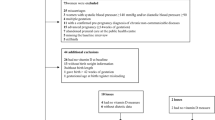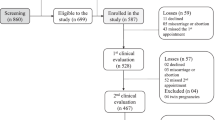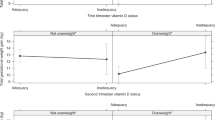Abstract
Background/Objectives:
Maternal vitamin D deficiency during pregnancy may influence offspring kidney health. We aimed to examine the associations of 25-hydroxyvitamin D (25(OH)D) blood levels during fetal life with kidney outcomes at school age.
Subjects/Methods:
This study was embedded in a population-based prospective cohort study among 4212 mother–child pairs. We measured maternal second trimester (18–25 weeks) and fetal cord blood (at birth) 25(OH)D levels. At a median age of 6.0 years, we measured children’s combined kidney volume, glomerular filtration rate (eGFR) from creatinine and cystatin C serum levels, and microalbuminuria from albumin and creatinine urine levels.
Results:
Of all mothers, 21.9% had severely deficient levels (25(OH)D <25.0 nmol/l), 25.7% had deficient levels (25.0–49.9 nmol/l), 25% had sufficient levels (50.0–74.9 nmol/l) and 27.4% had optimal levels (⩾75.0 nmol/l). Maternal 25(OH)D levels were not consistently associated with childhood combined kidney volume. Higher maternal 25(OH)D levels were associated with lower childhood eGFR (difference −0.94 ml/min per 1.73 m2 (95% confidence interval, −1.73; −0.15) per 1 standard deviation (s.d.) increase in 25(OH)D). Maternal 25(OH)D levels were not associated with microalbuminuria. Cord blood 25(OH)D levels were not associated with childhood kidney outcomes. The associations of maternal 25(OH)D levels with childhood eGFR were partly explained by childhood vitamin D status.
Conclusions:
Our findings suggest that maternal 25(OH)D levels during pregnancy may influence childhood kidney outcomes. These results should be considered hypothesis generating. Further studies are needed to replicate the observations, to examine the underlying mechanisms and to identify the long-term clinical consequences.
This is a preview of subscription content, access via your institution
Access options
Subscribe to this journal
Receive 12 print issues and online access
$259.00 per year
only $21.58 per issue
Buy this article
- Purchase on Springer Link
- Instant access to full article PDF
Prices may be subject to local taxes which are calculated during checkout

Similar content being viewed by others
References
Gale CR, Robinson SM, Harvey NC, Javaid MK, Jiang B, Martyn CN et al. Maternal vitamin D status during pregnancy and child outcomes. Eur J Clin Nutr 2008; 62: 68–77.
Crozier SR, Harvey NC, Inskip HM, Godfrey KM, Cooper C, Robinson SM et al. Maternal vitamin D status in pregnancy is associated with adiposity in the offspring: findings from the Southampton Women's Survey. Am J Clin Nutr 2012; 96: 57–63.
Hanieh S, Ha TT, Simpson JA, Thuy TT, Khuong NC, Thoang DD et al. Maternal vitamin D status and infant outcomes in rural Vietnam: a prospective cohort study. PLoS One 2014; 9: e99005.
Bouvard B, Annweiler C, Salle A, Beauchet O, Chappard D, Audran M et al. Extraskeletal effects of vitamin D: facts, uncertainties, and controversies. Joint Bone Spine 2011; 78: 10–16.
Robinson PD, Hogler W, Craig ME, Verge CF, Walker JL, Piper AC et al. The re-emerging burden of rickets: a decade of experience from Sydney. Arch Dis Child 2006; 91: 564–568.
Harvey NC, Moon RJ, Sayer AA, Ntani G, Davies JH, Javaid MK et al. Maternal antenatal vitamin D status and offspring muscle development: findings from the Southampton Women's Survey. J Clin Endocrinol Metab 2014; 99: 330–337.
Maka N, Makrakis J, Parkington HC, Tare M, Morley R, Black MJ . Vitamin D deficiency during pregnancy and lactation stimulates nephrogenesis in rat offspring. Pediatr Nephrol 2008; 23: 55–61.
Nascimento FA, Ceciliano TC, Aguila MB, Mandarim-de-Lacerda CA . Maternal vitamin D deficiency delays glomerular maturity in F1 and F2 offspring. PLoS One 2012; 7: e41740.
Boyce AC, Palmer-Aronsten BJ, Kim MY, Gibson KJ . Maternal vitamin D deficiency programmes adult renal renin gene expression and renal function. J Dev Orig Health Dis 2013; 4: 368–376.
Gluckman PD, Hanson MA, Cooper C, Thornburg KL . Effect of in utero and early-life conditions on adult health and disease. N Engl J Med 2008; 359: 61–73.
Hinchliffe SA, Sargent PH, Howard CV, Chan YF, van Velzen D . Human intrauterine renal growth expressed in absolute number of glomeruli assessed by the disector method and Cavalieri principle. Lab Invest 1991; 64: 777–784.
Brenner BM, Lawler EV, Mackenzie HS . The hyperfiltration theory: a paradigm shift in nephrology. Kidney Int 1996; 49: 1774–1777.
Jaddoe VWV, van Duijn CM, Franco OH, van der Heijden AJ, van Iizendoorn MH, de Jongste JC et al. The Generation R Study: design and cohort update 2012. Eur J Epidemiol 2012; 27: 739–756.
Kruithof CJ, Kooijman MN, van Duijn CM, Franco OH, de Jongste JC, Klaver CC et al. The Generation R Study: Biobank update 2015. Eur J Epidemiol 2014; 29: 911–927.
Eyles D, Anderson C, Ko P, Jones A, Thomas A, Burne T et al. A sensitive LC/MS/MS assay of 25OH vitamin D3 and 25OH vitamin D2 in dried blood spots. Clin Chim Acta 2009; 403: 145–151.
Holick MF . Vitamin D deficiency. N Engl J Med 2007; 357: 266–281.
Voortman T, van den Hooven EH, Heijboer AC, Hofman A, Jaddoe VW, Franco OH . Vitamin D deficiency in school-age children is associated with sociodemographic and lifestyle factors. J Nutr 2015; 45: 791–798.
Ross AC, Manson JE, Abrams SA, Aloia JF, Brannon PM, Clinton SK et al. The 2011 report on dietary reference intakes for calcium and vitamin D from the Institute of Medicine: what clinicians need to know. J Clin Endocrinol Metab 2011; 96: 53–58.
Sioen I, Mouratidou T, Kaufman JM, Bammann K, Michels N, Pigeot I et al. Determinants of vitamin D status in young children: results from the Belgian arm of the IDEFICS (Identification and Prevention of Dietary- and Lifestyle-Induced Health Effects in Children and Infants) Study. Public Health Nutr 2012; 15: 1093–1099.
Vogeser M . Quantification of circulating 25-hydroxyvitamin D by liquid chromatography-tandem mass spectrometry. J Steroid Biochem Mol Biol 2010; 121: 565–573.
Miliku K, Voortman T, Bakker H, Hofman A, Franco OH, Jaddoe VW . Infant breastfeeding and kidney function in school-aged children. Am J Kidney Dis 2015; 66: 421–428.
Geelhoed JJM, Taal HR, Steegers EAP, Arends LR, Lequin M, Moll HA et al. Kidney growth curves in healthy children from the third trimester of pregnancy until the age of two years. The Generation R Study. Pediatr Nephrol 2010; 25: 289–298.
Geelhoed JJ, Kleyburg-Linkers VE, Snijders SP, Lequin M, Nauta J, Steegers EA et al. Reliability of renal ultrasound measurements in children. Pediatr Nephrol 2009; 24: 1345–1353.
Schwartz GJ, Munoz A, Schneider MF, Mak RH, Kaskel F, Warady BA et al. New equations to estimate GFR in children with CKD. J Am Soc Nephrol 2009; 20: 629–637.
Zappitelli M, Parvex P, Joseph L, Paradis G, Grey V, Lau S et al. Derivation and validation of cystatin C-based prediction equations for GFR in children. Am J Kidney Dis 2006; 48: 221–230.
Donaghue KC, Chiarelli F, Trotta D, Allgrove J, Dahl-Jorgensen K . Microvascular and macrovascular complications. Pediatr Diabetes 2007; 8: 163–170.
Klipstein-Grobusch K, den Breeijen JH, Goldbohm RA, Geleijnse JM, Hofman A, Grobbee DE et al. Dietary assessment in the elderly: validation of a semiquantitative food frequency questionnaire. Eur J Clin Nutr 1998; 52: 588–596.
Centre for Research and Statistics, Centrum voor Onderzoek en Statistiek: Rotterdam, The Netherlands, 2005, Available from http://www.rotterdam.nl/onderzoek.
Statistiek CBvd Immigrants in the Netherlands 2004. Statistics Netherlands: Netherland, 2004.
Niklasson A, Ericson A, Fryer JG, Karlberg J, Lawrence C, Karlberg P . An update of the Swedish reference standards for weight, length and head circumference at birth for given gestational age (1977-1981). Acta Paediatr Scand 1991; 80: 756–762.
Sterne JA, White IR, Carlin JB, Spratt M, Royston P, Kenward MG et al. Multiple imputation for missing data in epidemiological and clinical research: potential and pitfalls. BMJ 2009; 338: b2393.
Rubin DB, Schenker N . Multiple imputation in health-care databases: an overview and some applications. Stat Med 1991; 10: 585–598.
Harvey NC, Holroyd C, Ntani G, Javaid K, Cooper P, Moon R et al. Vitamin D supplementation in pregnancy: a systematic review. Health Technol Assess 2014; 18: 1–190.
Bakker J, Olree M, Kaatee R, de Lange EE, Moons KG, Beutler JJ et al. Renal volume measurements: accuracy and repeatability of US compared with that of MR imaging. Radiology 1999; 211: 623–628.
Luyckx VA, Brenner BM . The clinical importance of nephron mass. J Am Soc Nephrol 2010; 21: 898–910.
Bacchetta J, Cochat P, Rognant N, Ranchin B, Hadj-Aissa A, Dubourg L . Which creatinine and cystatin C equations can be reliably used in children? Clin J Am Soc Nephrol 2011; 6: 552–560.
Filler G, Bokenkamp A, Hofmann W, Le Bricon T, Martinez-Bru C, Grubb A . Cystatin C as a marker of GFR—history, indications, and future research. Clin Biochem 2005; 38: 1–8.
Groesbeck D, Kottgen A, Parekh R, Selvin E, Schwartz GJ, Coresh J et al. Age, gender, and race effects on cystatin C levels in US adolescents. Clin J Am Soc Nephrol 2008; 3: 1777–1785.
Brenner BM, Chertow GM . Congenital oligonephropathy and the etiology of adult hypertension and progressive renal injury. Am J Kidney Dis 1994; 23: 171–175.
de Boer IH, Ioannou GN, Kestenbaum B, Brunzell JD, Weiss NS . 25-Hydroxyvitamin D levels and albuminuria in the Third National Health and Nutrition Examination Survey (NHANES III). Am J Kidney Dis 2007; 50: 69–77.
de Boer IH, Katz R, Chonchol M, Ix JH, Sarnak MJ, Shlipak MG et al. Serum 25-hydroxyvitamin D and change in estimated glomerular filtration rate. Clin J Am Soc Nephrol 2011; 6: 2141–2149.
Brown AJ, Dusso A, Slatopolsky E . Vitamin D. Am J Physiol 1999; 277: F157–F175.
Acknowledgements
The Generation R Study is conducted by the Erasmus University Medical Center in close collaboration with the School of Law and Faculty of Social Sciences of the Erasmus University Rotterdam, the Municipal Health Service Rotterdam area, Rotterdam, the Rotterdam Homecare Foundation, Rotterdam and the Stichting Trombosedienst and Artsenlaboratorium Rijnmond, Rotterdam. We gratefully acknowledge the contribution of participating mothers, general practitioners, hospitals, midwives and pharmacies in Rotterdam. The general design of the Generation R Study was made possible by financial support from the following: Erasmus Medical Center, Rotterdam; Erasmus University, Rotterdam; the Dutch Ministry of Health, Welfare and Sport; and the Netherlands Organization for Health Research and Development (ZonMw). K Miliku has been financially supported through Erasmus Mundus Western Balkans (ERAWEB), a project funded by the European Commission. T Voortman and O Franco work in ErasmusAGE, a research center funded by Nestlé Nutrition (Nestec Ltd), Metagenics Inc. and AXA. The vitamin D assay was supported by the Australian National Health and Medical Research Council (NHMRC APP1062846). Dr John McGrath received a NHMRC John Cade Fellowship (APP1056929). VWV Jaddoe received an additional grant from the Netherlands Organization for Health Research and Development (VIDI 016.136.361) and an European Research Council Consolidator Grant (ERC-2014-CoG-648916).
Author contributions
KM, TV and VWVJ designed the research and wrote the paper; AH, HT, OHF and VWVJ were involved in the design and planning of the study and data collection; JM, DE and TB performed the vitamin D assays on maternal and cord blood. KM and TV analyzed the data; JM, DE, TB, AH, HT, OHF and VWVJ provided comments and consultation regarding the analyses and manuscript; KM and VWVJ had primary responsibility for the final content. All authors critically reviewed and gave final approval of the version to be published.
Author information
Authors and Affiliations
Corresponding author
Ethics declarations
Competing interests
The authors declare no conflict of interest.
Additional information
Supplementary Information accompanies this paper on European Journal of Clinical Nutrition website
Supplementary information
Rights and permissions
About this article
Cite this article
Miliku, K., Voortman, T., Franco, O. et al. Vitamin D status during fetal life and childhood kidney outcomes. Eur J Clin Nutr 70, 629–634 (2016). https://doi.org/10.1038/ejcn.2015.216
Received:
Revised:
Accepted:
Published:
Issue Date:
DOI: https://doi.org/10.1038/ejcn.2015.216
This article is cited by
-
Investigation of 7-dehydrocholesterol reductase pathway to elucidate off-target prenatal effects of pharmaceuticals: a systematic review
The Pharmacogenomics Journal (2016)



